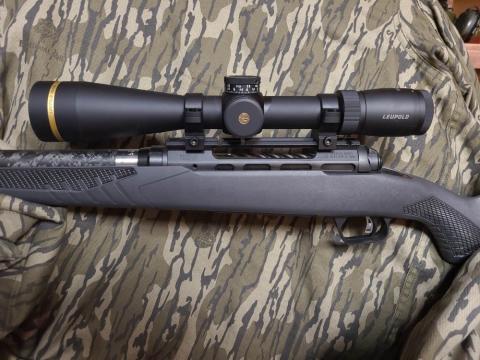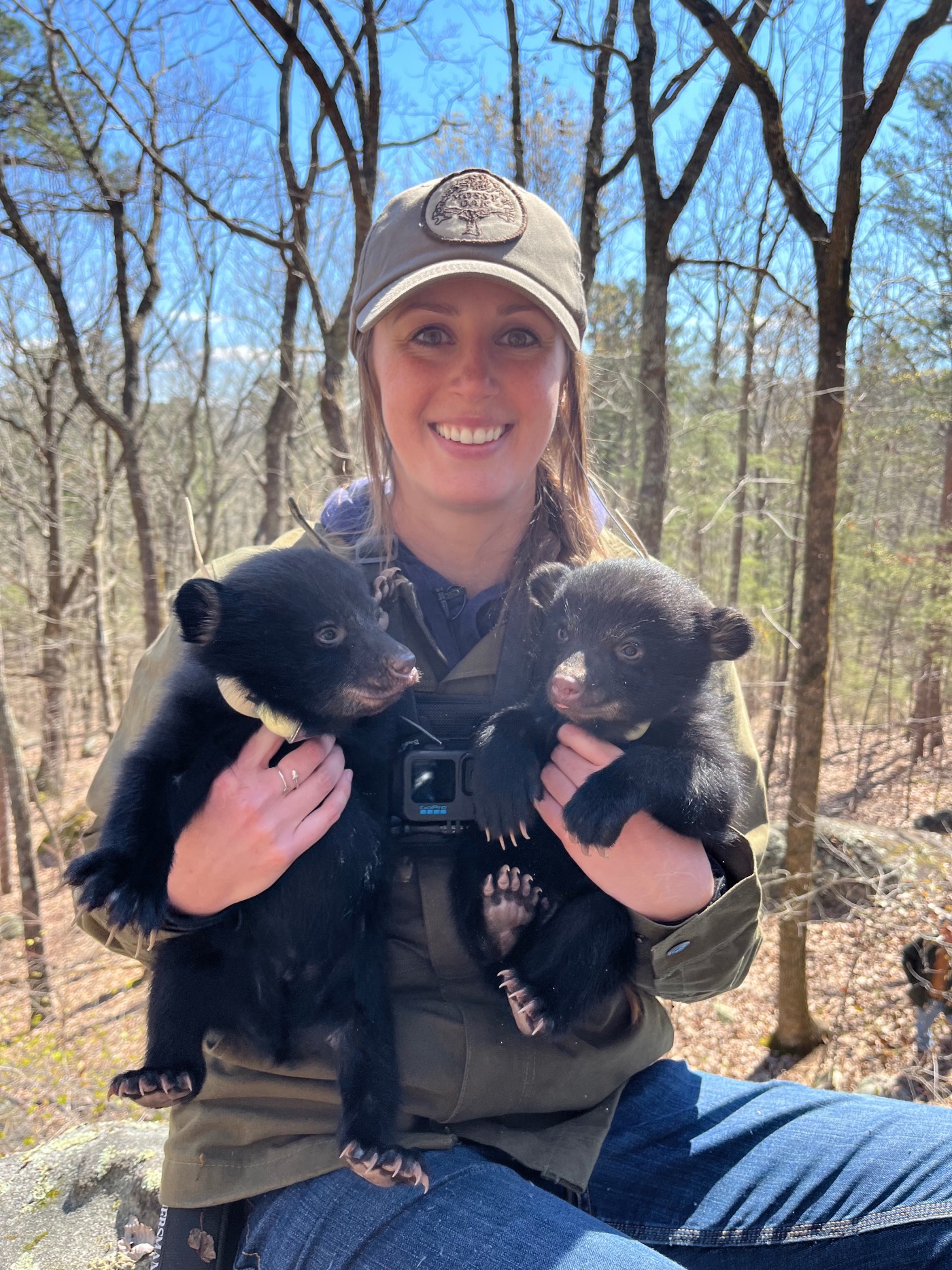
Pictured: Hannah Leeper and two of the four black bears we collared together.
Written by Jessi Cole
Growing up in the woods and generally outside, I’ve always been told two important rules regarding bears (relatively useless advice for the Mississippi woods in the 90s and 00s but apparently still important enough to learn) is: 1. Don’t poke the bear. 2. Never get between a mama bear and her cubs.
This March, in northeast Alabama, I was setting out with biologist Hannah Leeper to do both of these things.
Historically, in the 1800s and 1900s, the Alabama bear population was native to all of Alabama, and occurring largely in the southern region of the state, like the Mobile, Washington, and Clarke counties. However, due to habitat modification, human settlement, and over-harvest, only a small black bear population survived down in Mobile. In 2015, this population was estimated at 76 bears, an extremely small and genetically isolating number. A number in which every cub’s survival is crucial.
In recent years, though, a new population has emerged in northeast Alabama, a naturally recolonizing population, which means they’ve come down through their own will and natural instincts to spread out. The northeast population, estimated at 34 in 2015, come from a few black bears that wandered over from Georgia and set up camp in the area.
Hannah Leeper, biologist nicknamed “The Bear Lady” by the locals of Alabama, says, “It’s safe to say the population is exploding up here. The bears are being bred young, they’re having large litters, and the cub survival rate is high. There’s room for growth. Plenty of dens and plenty of food.”
Leeper’s work studies the den success rate in northeast Alabama versus the Mobile population in south Alabama. Where the northern population flourishes, the remnant population in Mobile suffers from a high mortality rate in their cubs.
To determine what’s going on in the two populations, Leeper visits den sites in northern Alabama to determine what kind of den sites are being utilized (excavated root balls, brush piles, tree cavities, or rock crevices, typically) and take measurements and genetic samples from the cubs, as well as fit them with a GPS collar and place a tag in their armpits for unique identification.
Richie, a Gamekeeper field producer, and I met with Hannah mid-morning near the first site we were headed to. Because Hannah had trapped and tagged a number of bears last summer, she was able to keep up with their locations and determine which females were likely breeding and raising cubs in the den.
The first bear we visited was on private property, and Leeper had already gotten permission for our arrival and discussed her work with the landowners. These landowners were happy to comply with her needs and, naturally, interested in the project. Leeper finds this to typically be the case; she says, “Black bears are the Alabama state mammal. While there is some fear, of course, they’re charismatic. They’re fluffy and cute to some degree. People do like them.”
With the aid of the landowners’ directions and Leeper’s satellite, we left to find our first den of the day. Leeper knew this mama bear to be about 6 years old and guessed her to weigh around 175-200 pounds, at her peak size this time of the year. With an average black bear cub birthday of February 1, we were hopefully looking for six-week old cubs.
Richie and I followed Leeper into the woods, waiting as she paused to listen to her satellite and determine which direction and how far to go. When we approached a very rocky hillside, she knew that we were within about 20 yards of the bear and advised us to keep our eyes peeled. Exchanging a quick, nervous glace at each other, Richie and I turned on the cameras and concentrated.
We circled a tall rock formation probably 30 feet off the ground several times, probably for 5 minutes, confused and tentative. Leeper looked stumped. “She should be right here,” she said. Then she looked up at the high rock formation. “Surely not,” she said, turning to me and then looking back up. We craned our necks up to look at the top of the formation. She must be there, we thought.
We reconvened; Leeper went first. She climbed up and through a mess of thorns and bramble that was blocking the easiest way up. Once she was through the thorns, Richie and I tag-teamed to get her syringe-on-a-stick to her. In an ideal world, Leeper explained, she would be able to immobilize the mother with her syringe and she’d simply fall asleep where she lay. She’d later wake up with her cubs there with her, none the wiser on the data collection while she was sleeping. It is the least stressful scenario for the mom.
Leeper continued to finish the climb up, now armed with her 4-feet-long syringe, then she called down to us that she had eyes on the bears. Richie and I then made the climb up, prepared to hopefully catch the event on camera and, as the main priority, provide assistance to Leeper should she need it.
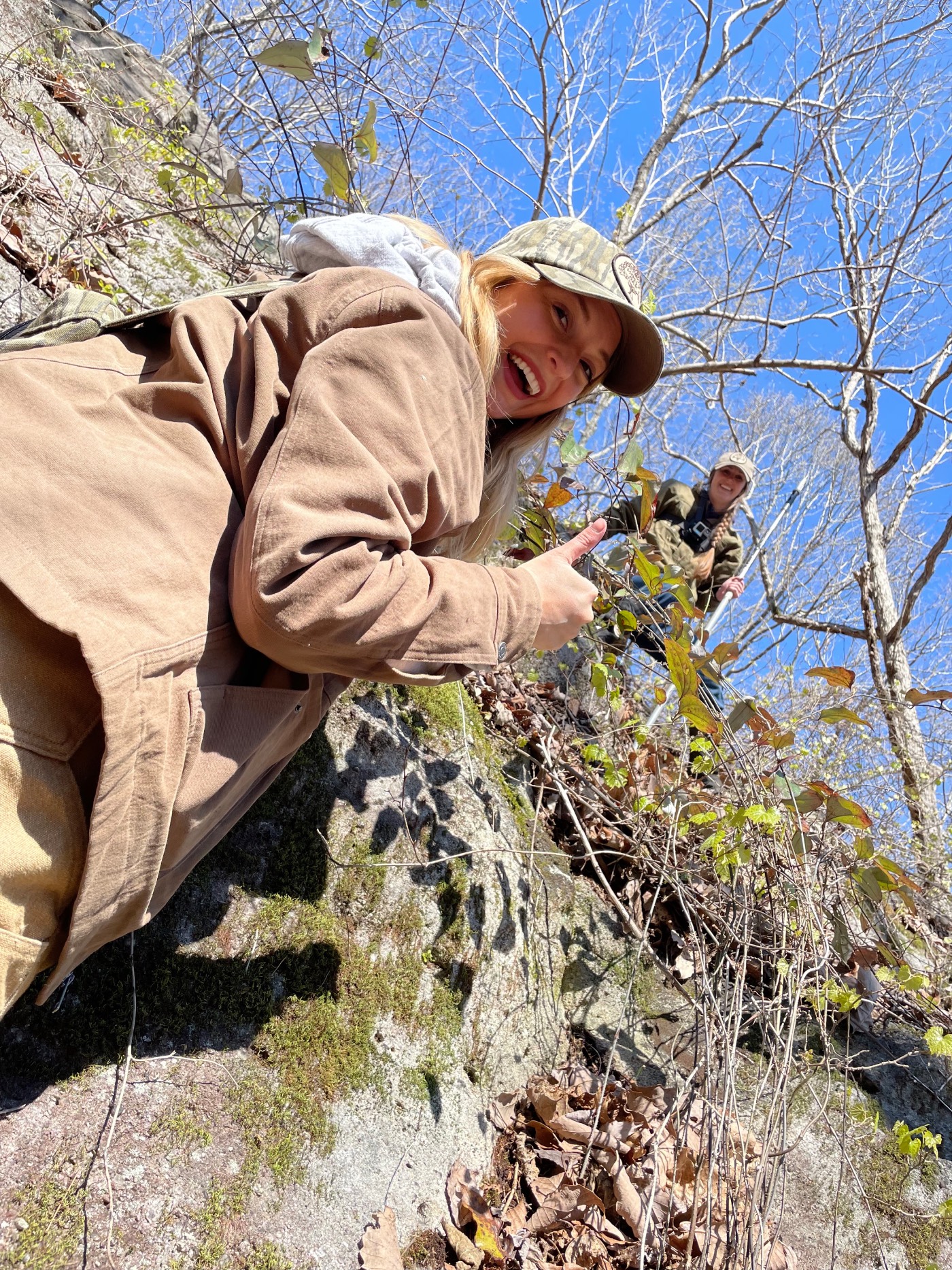
Hannah Leeper and I climbing up to the top of the rock formation.
Once Richie and I were posted on either side of the cave opening, all three of us 30 feet in the air, we gave Leeper the clear to go ahead and attempt to immobilize the bear. It looked like the bear’s only exit was through Hannah then through either Richie or I in order to get off the formation. If she didn’t immediately fall asleep or remain hunkered down with her cubs, it was likely one of us was going to have a frightened bear run past us on a one-foot-wide footpath. We trusted Leeper to make the calls and were ready to provide any kind of backup we could.
Hannah jabbed the bear and the bear immediately exited the cave from a back entrance that we hadn’t seen. I was the only one in a position to see the bear exit; she jumped 15 feet off and did a classic tuck-and-roll maneuver. She ambled off, looking back over her shoulder at us, and disappeared into the woods. Hannah said the bear hadn’t gotten any of the drug and that she was likely circling, watching, and waiting for us to leave.
Richie and I then rushed to help Leeper remove two, small, disgruntled bear cubs that she estimated to be six-weeks-old: exactly what we were looking for.
Leeper weighed each cub, measured the length of their hair, removed some of their hair for genetic testing, and gave each one their pit tag. She then attached the collar on them, explaining to us that the collars are designed to grow with them until they finally slide off when they reach about nine months old.
The cubs were each about 5 pounds, adorable, soft, and outfitted with little razor claws. Like a big kitten, basically. They were good at burrowing into us and at sticking to our shirts like Velcro when we needed to move them. They emitted little growls and grunts, fussing at us for removing them from their warm, safe den.
Once Leeper had collected all the data she needed, we returned the cubs to their den and backed out to allow the mother to return. An unusual but good den, noted Leeper. Although, she guessed it will pose some challenges once the cubs are active and mobile.
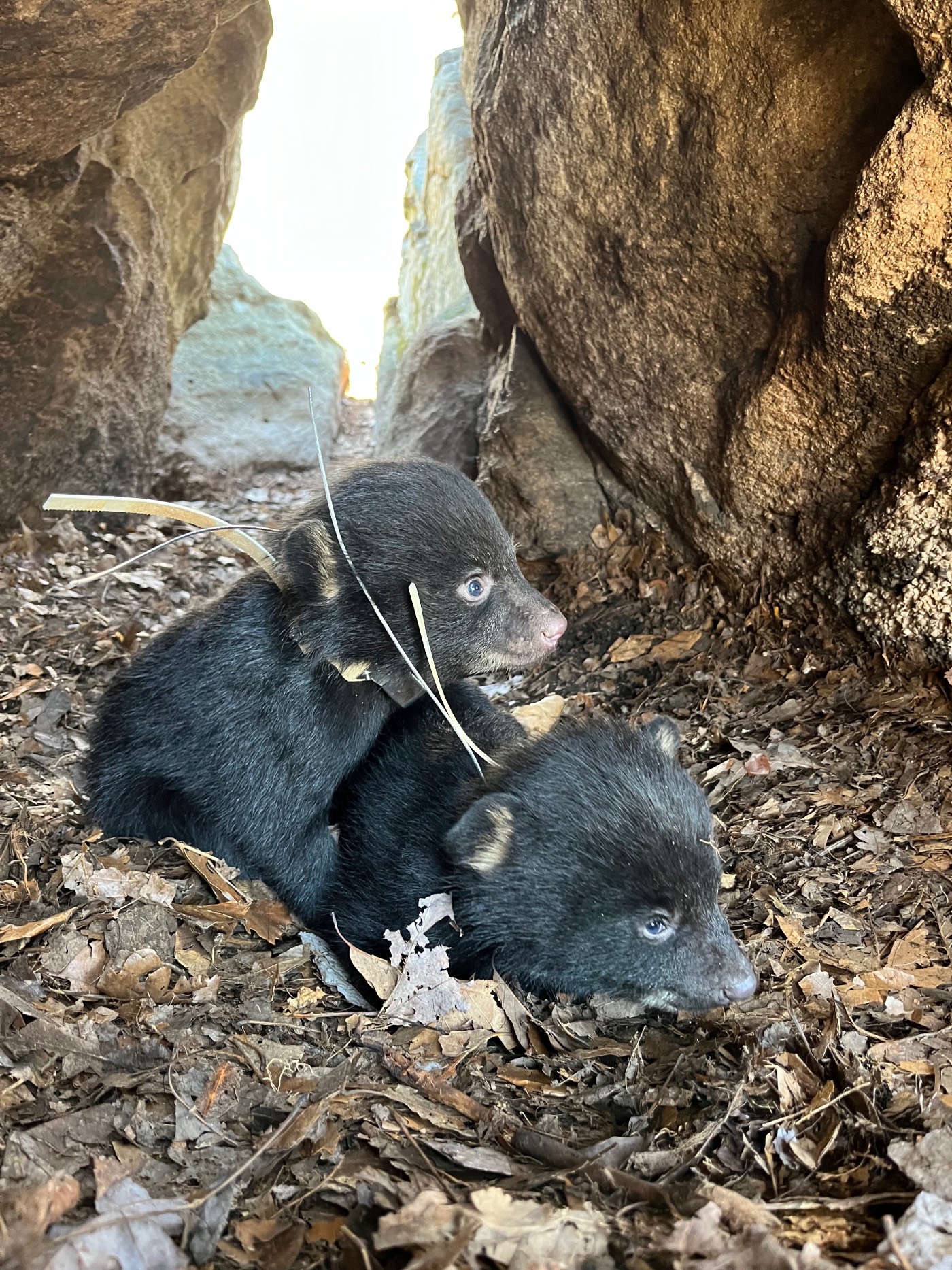
These cubs enjoyed a safe and dry den.
The next den we went to, probably 30 miles away, proved to be just as nerve-wracking and exciting. This den was on open ground only 50 yards from a gravel road. There was plenty of thick brush and brambles around for them to hide, but this den, sunny and open, was vastly different than the dark and well-hidden one we had just left.
This mama saw us pretty early on, but instead of running off, she decided to hold her ground. We kept making noise and creeping on towards her, raising our voices in a gentle, controlled manner that kept her aware of where we were. Finally, she decided to back up about 60 yards and watch us. We made our way to her two cubs, a male and female, and Leeper collected the same data from these two as the others. Age, genetics, weight. These two were a whole pound bigger than the first two; Leeper said they among the “chunkiest” she’d seen so far that year.
Black bear cubs are born at about one pound; the mother’s short gestational period (four months from implantation—there is a delayed implantation after breeding that complicates the numbers) produces an incredibly small, helpless cub. The first few weeks of life are the most dangerous and they’re very vulnerable at this stage. The cubs will stay with her until they’re about 18 months old, basically teenagers, at which time the mother is ready to be bred again.
On the second den, Leeper said, “This is not a good den, but it’s not uncommon that they’re here. This mom seems to like these kinds of open dens. She’s had successful survival rates, and you saw her stand her ground. She’s defensive in a good way.”
We tucked the cubs back behind the log they were near and let the mother return. Richie and I needed to begin our drive home, and Hannah had more work to do in the field.
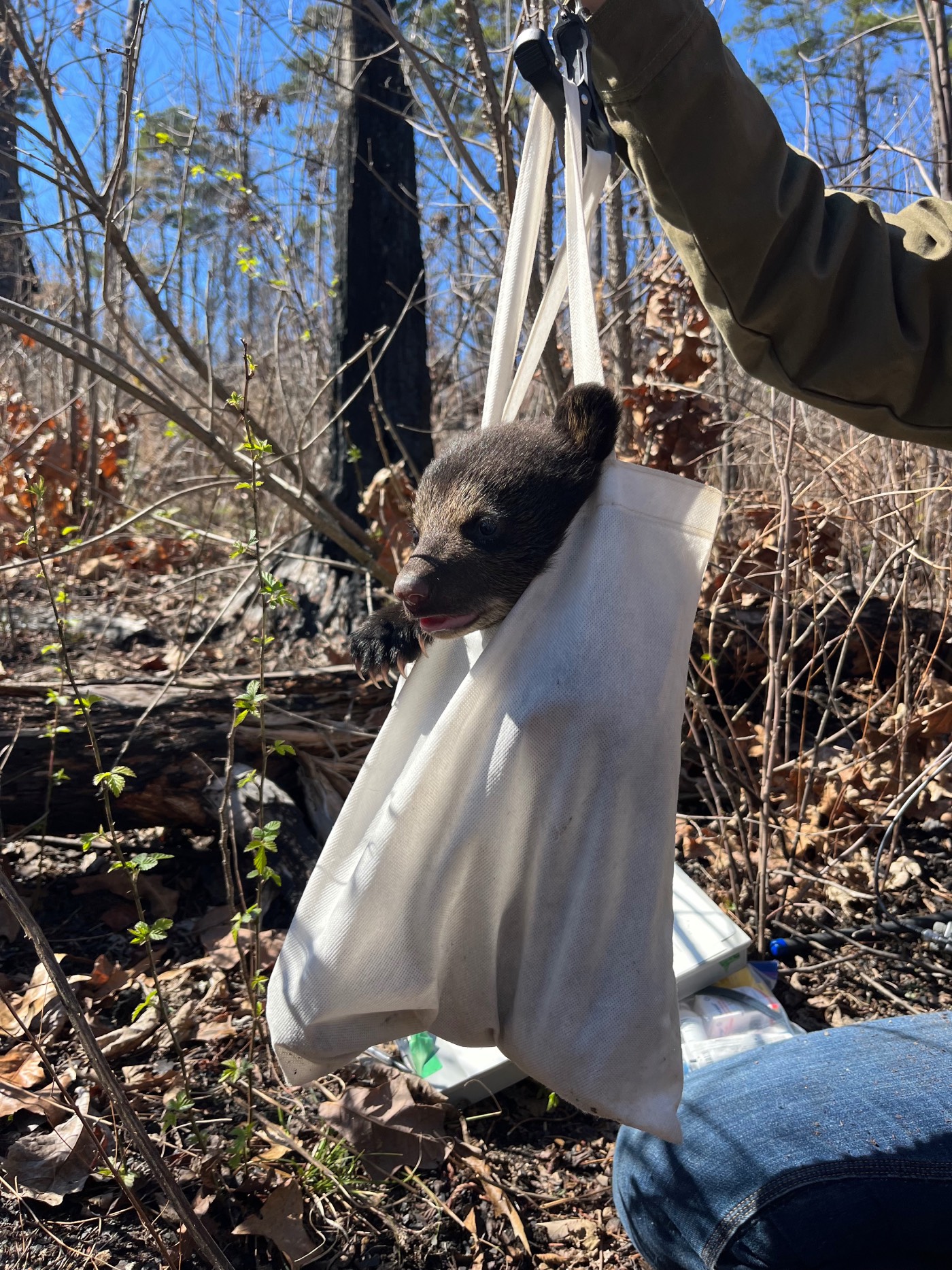
Hannah weighs this six-week-old black bear cub.
It’s hard for Leeper not to become emotionally attached to each bear. She talked about what she’d do if the collars or tags sent a mortality signal—retrieve the dead bear and have a necropsy done—with professionalism and tact. But it’s obvious how much she cares and loves the black bears she works with.
In order to prevent emotional attachment, she doesn’t name the bears; instead, each bear receives a number. I told her, “I would imagine you do get attached to these bears, though, even to the numbers.”
“Yep, absolutely” she replied. “Some of them have been collared for years. I get to know them, and I think they get to know me.”
It’s hard especially to keep emotions in check when foul play is suspected in the death of the bears. Leeper once tracked a male bear to someone’s backyard, where he was lying heavily decomposed and had all four paws missing. She called the game warden, but ultimately, nothing could be proven.
“It was devastating,” she said. “It’s so hard to catch a bear. The information that they give us is crucial. And I get emotionally attached to each bear.”
With the recent population rise in her region of Alabama, Leeper works hard to educate some wary locals to the bear’s cause. She wants to encourage an accurate understanding of what many have deemed a violent or frightening animal.
“They’re misunderstood,” she said. “They’re perceived as ferocious, but really they’re just shy.” Black bears are opportunistic omnivores. “Like big racoons,” she explained. “They’re lazy.”
It’s easy for someone to get the wrong impression of a black bear. Leeper said, “I’m trying to educate and teach people about bears before they become afraid or before bears are seen as a nuisance. Yes, they’re still a wild animal and, yes, they can be unpredictable. It’s good to have a respectable fear of bears. But there is no reason to be afraid of them.”
And with the increase in numbers, Leeper recommends a start in the conversation for an Alabama harvest season. “We’re not there yet,” she said. “But it can take years to get things going. We need to start talking about it now if we want a season in the next 5-10 years.”
Leeper herself grew up hunting and fishing in Minnesota, and she says, “Harvest can be a great management technique. It’s very easy to manipulate, just give out more or less licenses. A harvest season simply means that the population is stable enough to handle it.”
Hannah Leeper’s work and research on Alabama black bears has been crucial. It was truly a gift to be able to assist and better understand the black bear through her teachings and passion for the animal.
These bears were handled according to IACUC protocol, and under research permits from Auburn University and the Alabama Department of Conservation and Natural Resources.
















